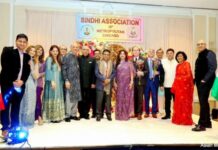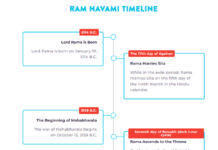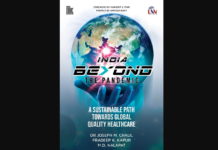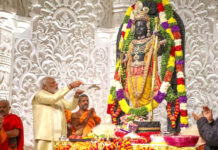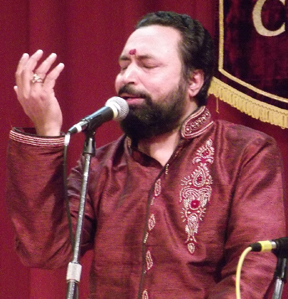
CHICAGO: Shertalai Ranganatha Sharma gave a Carnatic vocal concert here at the Hindu Temple of Greater Chicago May 25, the third and final day of the annual Tyagaraja Festival. He was accompanied on violin by Tiruvizha Viju Anand and on midrange by R. Sankaranarayanan.
Sharma began with a fixed composition (varnam) “Inthachala” in ragam Begada at fast pace culminating in a wonderful rendering of kalpana swaras for its final lines (charanam). Then followed a brief but scintillating exploration (unaccompanied by percussion, aalaapanam) of Reeti-gowla for the composition (kriti) “Baale balendu bhooshini” of Shyama Shastry, who is also one of the hallowed trinity of Carnatic music. Set to Aadi tala, it was neatly rendered with clear pronunciation of lyrics.
“Maravairamani” in Naasikaa-bhooshani, Rupaka tala, brought out Sharma’s rich imagination and creative skills in both aalaapanam and kriti. The excellent support from violin and mridangam made the concert that much more enjoyable.
After “Rarama intidaka” in Aasaveri, Sharma embarked on an elaborate aalaapanam in Kedara-gowla. Rich tradition and experience was manifest in his brilliant portrayal of various hues of this majestic raga, using characteristic note sequences (swara-sanchaara), before continuing with Tyagaraja’s famous “Tulasi Bilva” set to Aadi tala.
Its slow tempo (vilamba-kaala) allowed the artist to develop the raga with creative and imaginative variations (sangati). Sharma mesmerized with his musical phrase variations (neraval) on the line “Jalajaasana Sanakaadi karaarcita.” The impressive sol-fa improvisation (kalpana swara) that followed attested to amazing command over rhythm and fluency over the cascade of musical notes (swarara prasthara). The percussion solo (tani avartanam) by the mridangam, with its intricate jathi (patterns of rhythm), was highly enjoyable.
“Pahi parvata nandini,” a kriti of Maharaja Swathi Tirunal in ragam Aarabhi set to Aadi talam, was followed by a Hindi bhajan in Kalyana Vasanta. After rendering “Idu taano tillai sthalam” in Behag composed by Gopalakrishna Bharati, a well-known Tamil poet, Sharma concluded his memorable concert with a rhythmic dance piece (thillana) composed by the late violin maestro Lalgudi Jayaraman.
This year’s Tyagaraja Utsavam highlighted Kerala’s distinctive culture through its traditional temple orchestra (pancha-vaadyam), fanfare on cylindrical wooden drum (chenda melam) and group folk dance (kaikottikali) as preamble to the morning procession. Sharma, topped this celebration of India’s southeastern-most state by demonstrating the voice culture of its Carnatic musicians.
Jaishree Prasad



